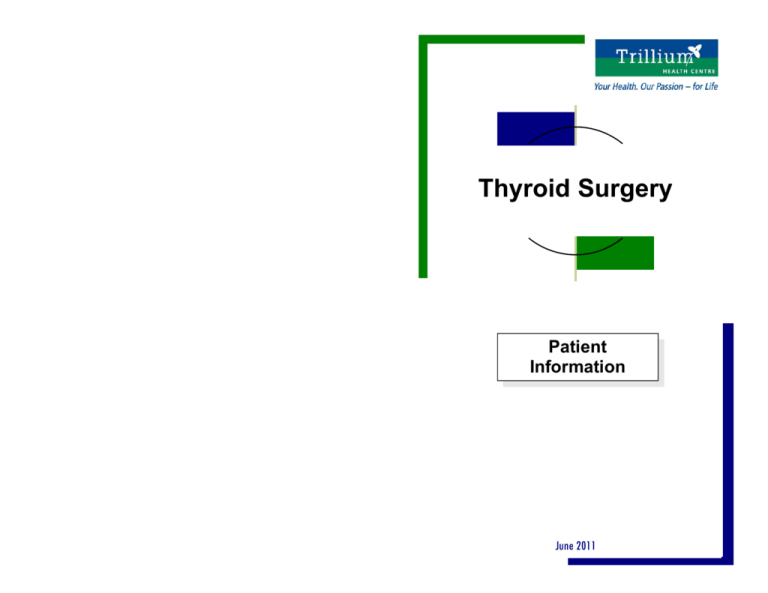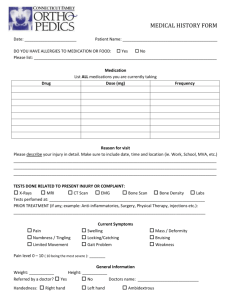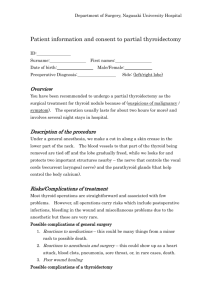Thyroid Surgery - Trillium Health Partners
advertisement

Thyroid Surgery Patient Information June 2011 Page 9 Page 2 When you require surgery, it is important to know what to expect. The information in this booklet will help you feel more prepared for your thyroid surgery. Your surgeon and nurse will give you more specific information about your individual case. Questions / Notes ________________________________________________ ________________________________________________ ________________________________________________ The Thyroid Gland ________________________________________________ The thyroid gland is located in the neck, just below the “Adams Apple” (thyroid cartilage). The illustration below shows arrows pointing to the thyroid gland. The gland produces thyroid hormones (e.g., thyroxine), which helps regulate how quickly the body uses energy. Thyroid hormones also help regulate calcium levels. ________________________________________________ ________________________________________________ ________________________________________________ ________________________________________________ Trillium Health Centre Mississauga Site 100 Queensway West Mississauga, ON L5B 1B8 (905) 848-7100 _____________________________ Thyroidectomy A thyroidecomy is the removal of all (a “total thyroidectomy”) or part (a “subtotal thyroidectomy”) of the thyroid gland. Thyroid surgery becomes necessary if the thyroid gland is enlarged, overactive, or if lumps (nodules) have developed on the gland. West Toronto Site 150 Sherway Drive Etobicoke, ON M9C 1A5 (416) 259-6671 Page 8 Page 3 Talk to your nurse to see if you need some help at home. Arrrange for someone to pick you up when you know the Most people recovery fairly quickly from thyroid surgery, and return home 1 or 2 days after the procedure. time/date you are going home. Your nurse will review your discharge instructions with you. You will receive a discharge instruction sheet, a followup doctor’s appointment, and any prescriptions for medications you need. Be sure to ask any questions you have before you are discharged home. Returning to Work Be sure to ask your surgeon when you can return to work. This will be confirmed at your follow-up appointment 10-14 days after surgery. What to Bring to the Hospital Have a family member/friend bring the following to the Surgical Unit after surgery: Comfortable, well-fitting shoes (running shoes or slippers with non-slip sole); all footwear must have closed heels and toes; Personal care items (toothbrush, hair brush, toothpaste); Housecoat. Getting Ready for Your Surgery Review this booklet. Make sure you are eating well before surgery; a healthy Follow-up Phone Call You will receive a follow-up telephone call at home from your nurse to make sure you are recovering well and to answer any questions you have. Call your surgeon’s office as soon as possible to arrange a follow-up appointment after your surgery. diet allows your body to build reserves that help with healing and recovery. Avoid smoking; this will help you recover well and prevent infection. Do not eat or drink anything after midnight the night before your surgery. You may take sips of water if ou need to take pills. How Will You Manage at Home After Surgery? Before surgery, make plans for the help you will need at home (e.g., groceries, cooking, child care, cleaning, etc.). Page 4 After Surgery Page 7 After that time, you may have a smaller dressing applied. You will wake up after surgery in the Recovery Room where a nurse will check you often. You will remain in the Recovery Room for the first 3-6 hours. After that time, you will be take to your room on the Surgery Unit. Hemovac Drain At the end of the operation, the surgeon will place a small “drain” at the neck. This hemovac drain is in place for 1-2 days to help your incision heal (pictured below). Your nurse will assess your hemovac drain, surgical dressing, and overall recovery. You will have your blood pressure and other vital signs, and neck girth measured every 4 hours initially. Be sure to tell the nurse how you are feeling. It is important to keep the area clean and dry. Stitches or Clips Your surgeon will use the best technique for your individual case to close your incision. This is done with clips (staples), sutures, or white tapes (steri-strips). If clips are used, these may be removed by the surgeon as early as the 1st or 2nd day after surgery. See illustration. If sutures are used, you will go home with these in place. Keep the area clean and dry. The sutures will be removed at your follow-up appointment with the surgeon in 10-14 days. White tapes (steri-strips) may be used to cover the sutures, or may be applied after the sutures are removed. See illustration. Going Home What are C&T Signs? (Chvostek and Trousseau Signs) Depending on your recovery, you will be discharged on An uncommon complication of thyroid surgery is a drop in your calcium level. Your lap work will be monitored for any change in your calcium level. Your nurse also checks for signs of low calcium by monitoring for muscle spasms, the 1st or 2nd day after surgery. It is important you begin planning for going home, even before you come to the hospital. Page 6 nausea and vomiting from previous anesthetics, tell the anesthesia doctor before your surgery. There are medications to help minimize this. It is important you feel comfortable after surgery. Tell your nurse if you have nausea or vomiting and you will be given medication to provide some relief. Lab Work After your surgery, you will have blood work draw to look at the level of calcium and other components in your blood. Occasionally, after thyroid surgery, calcium levels can become low. In this event, supplements of calcium will be ordered by your surgeon. Your surgeon will explain when to have more blood tests done after you go home. Thyroid Function If all of the thyroid gland is moved, you will require lifelong replacement thyroxine. This is easy to do by taking a daily dose of thyroid hormone, available in pill form. Care of Your Incision Page 5 particularly at your wrist or face. This is called C&T signs (Chvostek and Troussseau). To check for C&T signs, your nurse will tap gently just in front of year ear to check for muscle twitching of your face muscle (Chvostek’s sign). The nurse will also check for a positive Trousseau’s sign by inflating a blood pressure cuff for a few minutes and observe for twitching or spasms at your wrist or hands. Although complications are rare, be sure to tell your nurse if you have: Trouble breathing; Muscle spasms; Twitching or tingling in your lips for fingers. Pain Management After surgery, you will have some pain and neck stiffness. You will be provided pain medications to ensure you are as comfortable as possible. On the day of surgery, you may receive your pain medication through your intravenous line. Once you are able to drink fluids, you can progress taking pain medication in pill form. Keeping the head of the bed elevated can also improve your comfort. You will have a dressing that covers the area of surgery. Your nurse will explain how your incision is healing and Nausea and Vomiting how to care for this at home. Normally the initial surgical dressing is left in place for the first 24-48 hours. Some people feel stomach upset (nausea) and vomiting after surgery. If you have a history of motion sickness or








